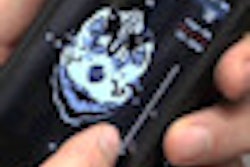
Radiologists can use the iPad to read a broad spectrum of emergency MR and CT cases commonly encountered during after-hours, on-call coverage, according to a Singapore study published online in the Journal of Digital Imaging.
A team from Changi General Hospital found low discrepancy rates between readers using an iPad and those using a PACS workstation for both clinically significant and insignificant findings on a group of typical emergency CT and MR cases. The three readers in the study also generally found the experience of reading images on the iPad to be a good one, although user interface improvements were needed, according to lead author Dr. Sindhu John.
"Primary radiological diagnoses for emergency CTs and MRIs made on the iPad appear to be accurate and comparable to those derived from PACS," John told AuntMinnie.com. "This is despite nonstandardization of reading conditions, which best reflects the 'real world' application of this technology and, as such, truly frees the radiologist from the constraints of his PC, laptop, or workstation."
 Apple's iPad produced comparable results versus a PACS workstation.
Apple's iPad produced comparable results versus a PACS workstation.
The researchers were fascinated by the potential of mobile computing devices for delivering timely and accurate radiological diagnosis and teleconsultation; as a result, they sought to investigate whether the iPad could be as accurate for diagnostic purposes as traditional PACS displays, John said.
The group also wanted to gather feedback from radiologists about their experiences using the iPad for diagnosis (J Digit Imaging, May 5, 2012).
To simulate a real-world scenario, the team retrospectively selected a sample of CT and MRI studies between July 2009 and January 2011 that represented a spectrum of acute conditions commonly encountered by an on-call radiologist. The cases comprised a mix of noncontrast and contrast-enhanced studies, including CT and MR angiography exams and their corresponding postprocessed images, according to the authors. Brain and spine studies for stroke, spinal trauma, or suspected cord compression with neurologic deficits were among the emergent MRI exams.
Seventy-nine CT studies and nine MRI exams were included in the study, along with 24 (22 CT and two MRI) arbitrarily selected normal cases. The CT images were produced on an Aquilion 64-slice CT scanner (Toshiba Medical Systems), while the MRI exams were generated on a Symphony 1.5-tesla system (Siemens Healthcare). Both used standard imaging protocols.
After the DICOM images were anonymized and transferred from the PACS server to a portable hard disk, they were wirelessly sent to a first-generation iPad via an Apple MacBook that was running version 3.9.2 OsiriX image viewing software. Studies were independently reviewed on the iPad by three readers who were board-equivalent attending radiologists with at least 10 years of experience in general radiology. Version 2.02 of the OsiriX HD software was used on the iPad.
The radiologists also filled out a user survey with a five-point Likert scale to rate the iPad on a number of variables. No attempts were made to standardize lighting, reading conditions, or reading time, John said. The radiologists' findings were then compared to the original radiology report produced from a standard PACS workstation employing 6-megapixel diagnostic display monitors (Barco).
An independent adjudicator determined if there were any discrepant findings and categorized them as major (clinically important findings that would affect immediate management and outcome) or minor (incidental findings that would not affect immediate management or outcome), according to the researchers. A single discrepant finding resulted in the entire study being considered discrepant.
Out of the 264 total reports produced by the three readers from the iPad, 240 (90%) were in total agreement with the original report on the PACS workstation. Nine (3.4%) of the discrepancies were judged to be major discrepant findings, and 15 were considered minor.
Of the nine major discrepancies, eight were on CT cases and one was from an MRI study. Three were considered to be interpretation errors, while six were detection errors.
"Two abnormalities were detected but were each interpreted incorrectly by one reader," the authors wrote. "These comprised a cerebral arteriovenous malformation misdiagnosed as a dural arteriovenous fistula as the nidus was very small, and a vesicoureteric junction calculus that was interpreted as a bladder calculus. One patient with pulmonary embolism was misdiagnosed as having features of right ventricular strain by one reader."
One reader each did not detect the remaining six major discrepant findings, which included the following:
- Two cases of traumatic intracranial hemorrhage, which were both on a background of multiple hemorrhages
- One small cerebral infarct
- One cecal foreign body
- One case where midline shift was not described in acute intracranial hemorrhage
The one major discrepant finding on MRI was a missed acute right cerebellar infarct on the background of multiple acute brain infarcts.
All 24 normal studies were correctly diagnosed by all three readers.
"The iPad is able to handle viewing of large studies with supplementary postprocessed images well, not merely small studies like CT brains," John noted.
The radiologists also generally found the iPad experience to be a good one, although all three rated the application as "poor" for stability.
"Vendors of RIS/PACS systems need to research and develop tablet applications for reviewing radiological images and improve [the] user interface and experience," John said.




















